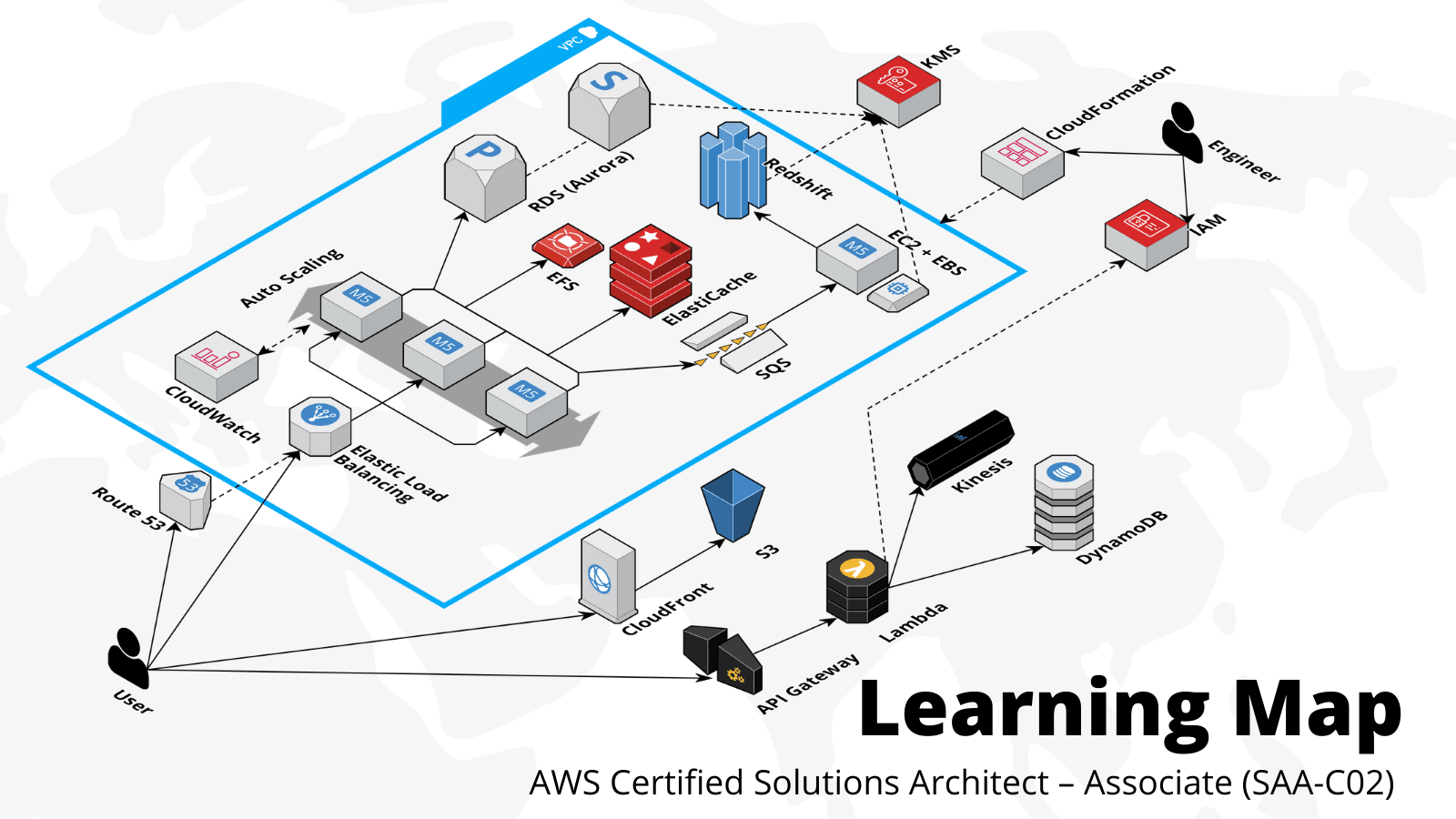How to Become an AWS Certified Solutions Architect
In 2012, I created my first AWS account. Back then, I worked as a software engineer and was looking for a way to deploy an online trading platform. Two years later, I attended re:Invent — the yearly conference organized by AWS — in Las Vegas for the first time. I was lucky to pass the Certified Solutions Architect certification without any preparation due to my hands-on experience.

This is a cross-post from the Cloudcraft blog.
Are you aiming to pass the Solutions Architect Associate (SAA-C02) exam? In this blog, you’ll find my advice on how to prepare for the certification exam. My approach is not the fastest way to get certified but a sustainable and joyful way to learn about AWS that will pay off in the long term.
The learning map
AWS is a vast country with its own language. Therefore, I’ve created a learning map to navigate AWS’s most important parts to pass the exam. Think of your exam preparations as a journey of discovery through this country.

Use the following checklist to track your learning progress.
- EC2
- VPC
- RDS
- ElastiCache
- EBS
- EFS
- IAM
- S3
- CloudWatch
- Auto Scaling
- Route 53
- CloudFront
- API Gateway
- Lambda
- DynamoDB
- Redshift
- KMS
- CloudFormation
The official exam guide describes the requirements to get certified in more detail.
What’s your learning style?
I prefer learning about new topics by reading a book. I do recommend the following two books to get started with AWS.
On top of that, I suggest reading through the AWS Well-Architected Framework. The framework summarizes best practices on how to build secure, reliable and efficient systems on AWS. You will find a lot of questions about those principles within the exam.
Do you prefer watching videos instead of reading? The place to go is A Cloud Guru with their AWS Certified Solutions Architect Associate SAA-C02 course consisting of more than 34 hours of videos. Besides that, Adrian Cantrill — an independent instructor — puts a lot of effort into his video courses. Of course, Adrian offers an AWS Certified Solutions Architect – Associate (SAA-C02) course as well.
Participating in instructor-led classroom training is another way of getting started with AWS. An onsite training breaks the daily routine and provides a place to concentrate. AWS and its partners offer training all around the world. Until last year, I was an instructor for official AWS training in Germany. Based on that experience, I do recommend the 3-day Architecting on AWS training.
Learning by doing
Reading books, watching videos and participating in classroom training is an excellent way to get familiar with AWS. However, I observe that learning by doing is even more critical. By the way, AWS recommends one year of hands-on experience (see exam guide).
In my opinion, a side project is a perfect way to learn about AWS. Get inspired by the following examples.
- Deploy a personal blog based on WordPress. Start with a single EC2 instance and expand to a highly available infrastructure with Route 53, ALB, EC2, Auto Scaling, EFS, and RDS.
- Back up data from your local machine or network to AWS. Start by using a basic S3 bucket and proceed with lifecycle policies to decrease costs, encryption-at-rest with a customer-managed KMS key, and scheduled backups with the help of AWS DataSync.
- Install your a VPN server — for example, OpenVPN — on an EC2 instance to tunnel your traffic through unsecured networks or to another country. Expand by accessing additional resources like an EFS file system over the VPN connection.
- When working on a side project to deepen your knowledge about AWS, you will most likely struggle from time to time. Therefore, we recommend joining a community of AWS users.
Join a community
There are AWS user groups all around the world. For example, I’m the co-organizer of the AWS user group in Stuttgart. And of course, there are online communities as well. For example, #100DaysOfCloud is a community of AWS/GCP/Azure beginners. Get involved, for example, with one of the following activities.
- Ask for help when you are struggling and need some guidance to get back on track.
- Watch talks where experts share their knowledge and experience.
- Share your side project to get motivating feedback.
- Help others as early as possible. Explaining a topic to a beginner is very helpful to deepen your understanding.
I highly recommend joining a community of AWS users!
Broaden your knowledge
After gaining some hands-on AWS experience, I encourage you to broaden your knowledge about AWS in two dimensions:
- Vertical: Pick 2-3 services in which you want to become an expert. Take a close look at every detail. I highly recommend testing the limits. For example, what’s the maximum network bandwidth of an EC2 instance? Or, how fast does an ALB scale?
- Horizontal: Add 2-3 services to your learning agenda. Pick services you are most interested in — for example, machine learning, analytics, or IoT.
Doing so helps you to see the bigger picture and to connect the dots.
Take a practice exam
So you learned a lot about AWS and gained some hands-on experience? Time for the last steps before the exam.
First, I recommend the exam readiness course from AWS. The free course summarizes important information and contains example questions. Next, I recommend taking the practice exam to build trust in your knowledge and sleep well before the final exam.
Go, go, go!
Did you pass the practice exam? Schedule a certification exam right away. Good luck, and don’t forget to share your success in the comments.
Further reading
- Article A recap of the re:Invent 2020 Keynote with Andy Jassy
- Article How to configure SAML for AWS SSO?
- Article Unusual AWS Architectures
- Tag career
- Tag highlight
